Logistics and Supply Chain Analysis for Business Development
VerifiedAdded on 2022/08/12
|9
|2861
|13
Homework Assignment
AI Summary
This assignment solution provides a comprehensive analysis of logistics and supply chain management, focusing on the requirements of two companies: Almarai (food and beverage) and Maaden (mining). It compares their similarities and differences in supply chain and logistics needs, including inventory management and material handling, and discusses potential logistical problems. The solution also examines the role of IT in logistics, providing examples of IT implementation in businesses. Furthermore, the assignment explores key predictors of supply chain performance efficiency, such as perfect order index, supply chain cycle time, and inventory management. Finally, the solution explains the Logistics Quantification Pyramid and its relation to the SCOR framework, highlighting its role in measuring and improving supply chain quality. The assignment leverages the SCOR framework for strategic decision-making to satisfy client expectations and demands. The assignment is a valuable resource for students studying business development and supply chain management.
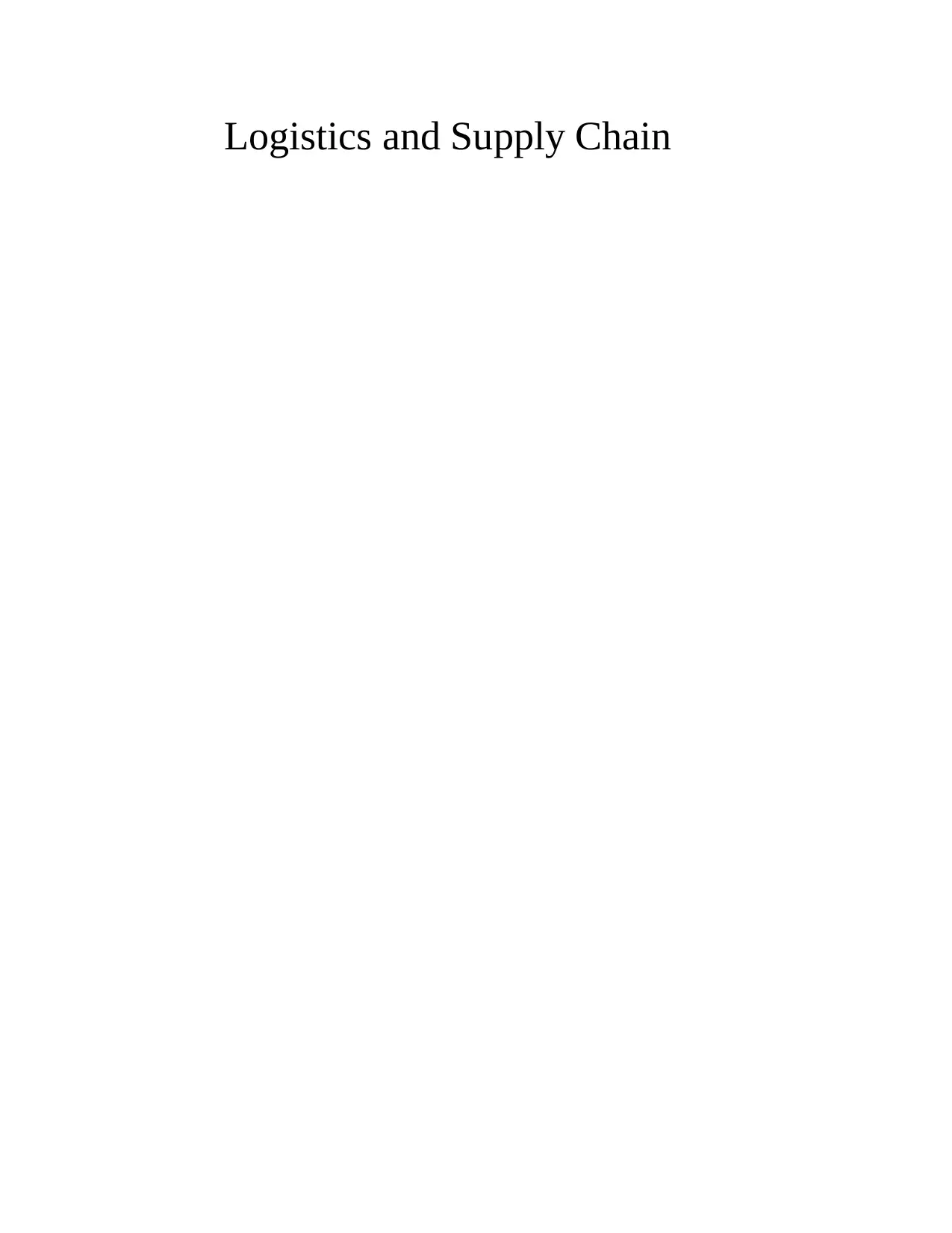
Logistics and Supply Chain
Paraphrase This Document
Need a fresh take? Get an instant paraphrase of this document with our AI Paraphraser
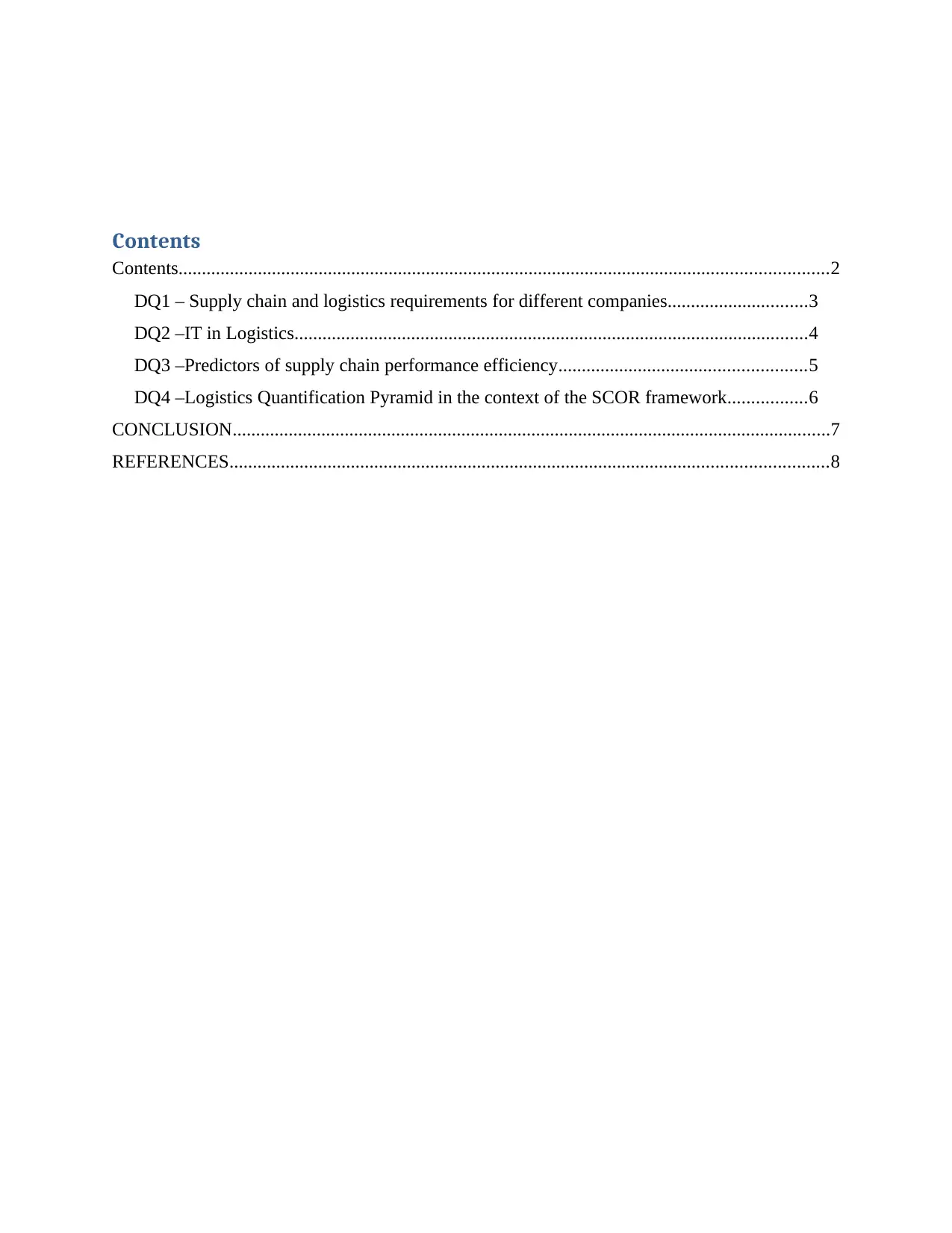
Contents
Contents...........................................................................................................................................2
DQ1 – Supply chain and logistics requirements for different companies..............................3
DQ2 –IT in Logistics..............................................................................................................4
DQ3 –Predictors of supply chain performance efficiency.....................................................5
DQ4 –Logistics Quantification Pyramid in the context of the SCOR framework.................6
CONCLUSION................................................................................................................................7
REFERENCES................................................................................................................................8
Contents...........................................................................................................................................2
DQ1 – Supply chain and logistics requirements for different companies..............................3
DQ2 –IT in Logistics..............................................................................................................4
DQ3 –Predictors of supply chain performance efficiency.....................................................5
DQ4 –Logistics Quantification Pyramid in the context of the SCOR framework.................6
CONCLUSION................................................................................................................................7
REFERENCES................................................................................................................................8
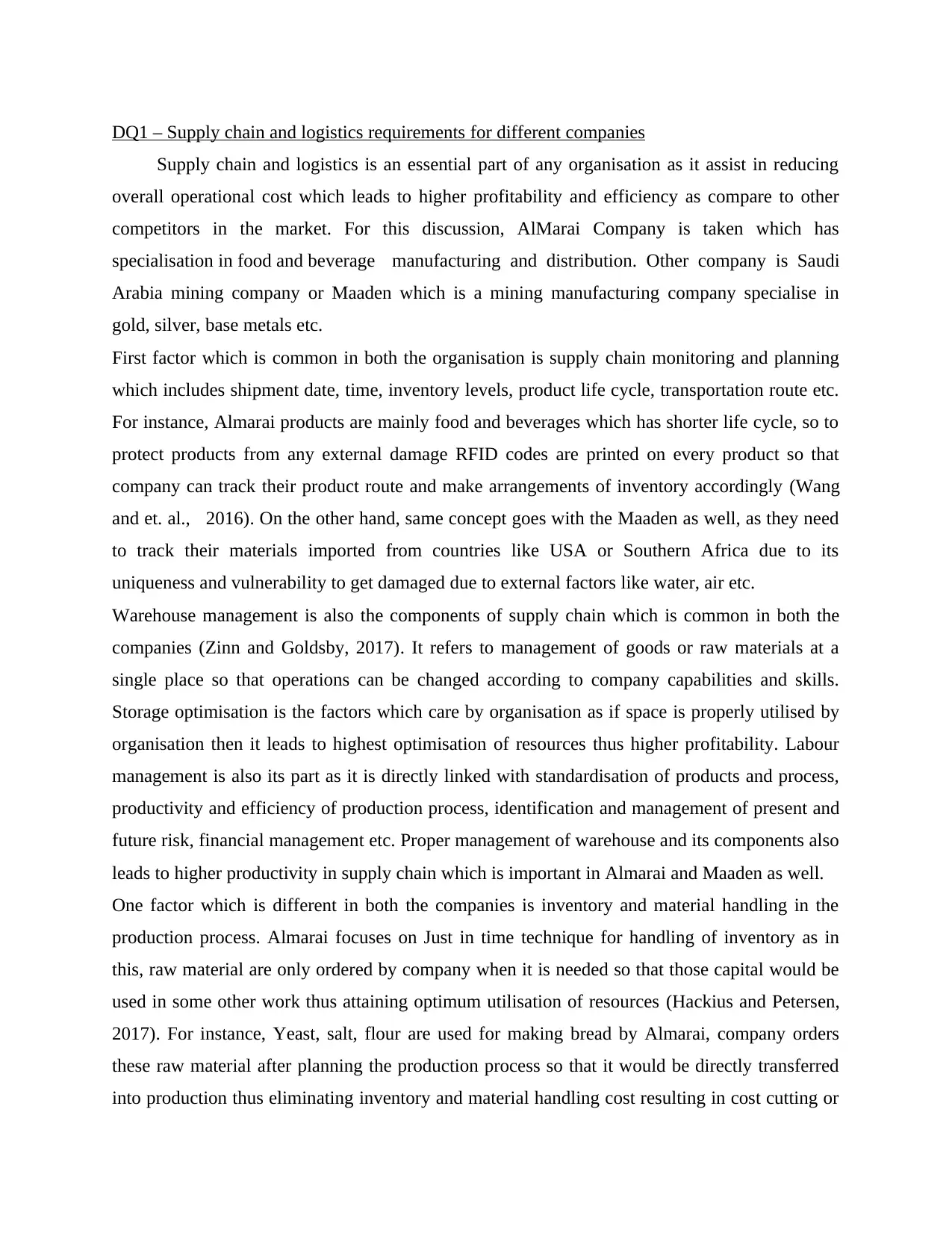
DQ1 – Supply chain and logistics requirements for different companies
Supply chain and logistics is an essential part of any organisation as it assist in reducing
overall operational cost which leads to higher profitability and efficiency as compare to other
competitors in the market. For this discussion, AlMarai Company is taken which has
specialisation in food and beverage manufacturing and distribution. Other company is Saudi
Arabia mining company or Maaden which is a mining manufacturing company specialise in
gold, silver, base metals etc.
First factor which is common in both the organisation is supply chain monitoring and planning
which includes shipment date, time, inventory levels, product life cycle, transportation route etc.
For instance, Almarai products are mainly food and beverages which has shorter life cycle, so to
protect products from any external damage RFID codes are printed on every product so that
company can track their product route and make arrangements of inventory accordingly (Wang
and et. al., 2016). On the other hand, same concept goes with the Maaden as well, as they need
to track their materials imported from countries like USA or Southern Africa due to its
uniqueness and vulnerability to get damaged due to external factors like water, air etc.
Warehouse management is also the components of supply chain which is common in both the
companies (Zinn and Goldsby, 2017). It refers to management of goods or raw materials at a
single place so that operations can be changed according to company capabilities and skills.
Storage optimisation is the factors which care by organisation as if space is properly utilised by
organisation then it leads to highest optimisation of resources thus higher profitability. Labour
management is also its part as it is directly linked with standardisation of products and process,
productivity and efficiency of production process, identification and management of present and
future risk, financial management etc. Proper management of warehouse and its components also
leads to higher productivity in supply chain which is important in Almarai and Maaden as well.
One factor which is different in both the companies is inventory and material handling in the
production process. Almarai focuses on Just in time technique for handling of inventory as in
this, raw material are only ordered by company when it is needed so that those capital would be
used in some other work thus attaining optimum utilisation of resources (Hackius and Petersen,
2017). For instance, Yeast, salt, flour are used for making bread by Almarai, company orders
these raw material after planning the production process so that it would be directly transferred
into production thus eliminating inventory and material handling cost resulting in cost cutting or
Supply chain and logistics is an essential part of any organisation as it assist in reducing
overall operational cost which leads to higher profitability and efficiency as compare to other
competitors in the market. For this discussion, AlMarai Company is taken which has
specialisation in food and beverage manufacturing and distribution. Other company is Saudi
Arabia mining company or Maaden which is a mining manufacturing company specialise in
gold, silver, base metals etc.
First factor which is common in both the organisation is supply chain monitoring and planning
which includes shipment date, time, inventory levels, product life cycle, transportation route etc.
For instance, Almarai products are mainly food and beverages which has shorter life cycle, so to
protect products from any external damage RFID codes are printed on every product so that
company can track their product route and make arrangements of inventory accordingly (Wang
and et. al., 2016). On the other hand, same concept goes with the Maaden as well, as they need
to track their materials imported from countries like USA or Southern Africa due to its
uniqueness and vulnerability to get damaged due to external factors like water, air etc.
Warehouse management is also the components of supply chain which is common in both the
companies (Zinn and Goldsby, 2017). It refers to management of goods or raw materials at a
single place so that operations can be changed according to company capabilities and skills.
Storage optimisation is the factors which care by organisation as if space is properly utilised by
organisation then it leads to highest optimisation of resources thus higher profitability. Labour
management is also its part as it is directly linked with standardisation of products and process,
productivity and efficiency of production process, identification and management of present and
future risk, financial management etc. Proper management of warehouse and its components also
leads to higher productivity in supply chain which is important in Almarai and Maaden as well.
One factor which is different in both the companies is inventory and material handling in the
production process. Almarai focuses on Just in time technique for handling of inventory as in
this, raw material are only ordered by company when it is needed so that those capital would be
used in some other work thus attaining optimum utilisation of resources (Hackius and Petersen,
2017). For instance, Yeast, salt, flour are used for making bread by Almarai, company orders
these raw material after planning the production process so that it would be directly transferred
into production thus eliminating inventory and material handling cost resulting in cost cutting or
⊘ This is a preview!⊘
Do you want full access?
Subscribe today to unlock all pages.

Trusted by 1+ million students worldwide
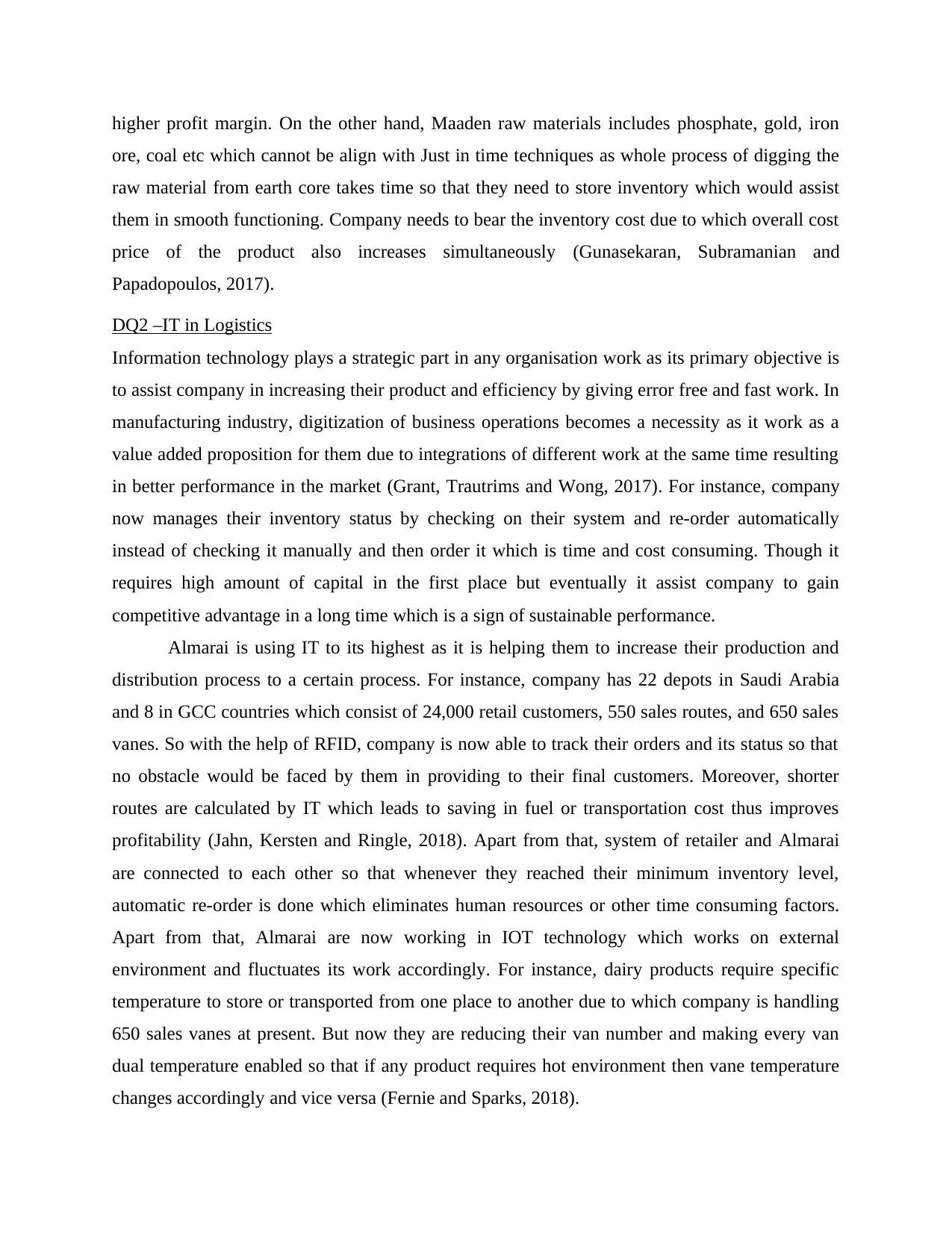
higher profit margin. On the other hand, Maaden raw materials includes phosphate, gold, iron
ore, coal etc which cannot be align with Just in time techniques as whole process of digging the
raw material from earth core takes time so that they need to store inventory which would assist
them in smooth functioning. Company needs to bear the inventory cost due to which overall cost
price of the product also increases simultaneously (Gunasekaran, Subramanian and
Papadopoulos, 2017).
DQ2 –IT in Logistics
Information technology plays a strategic part in any organisation work as its primary objective is
to assist company in increasing their product and efficiency by giving error free and fast work. In
manufacturing industry, digitization of business operations becomes a necessity as it work as a
value added proposition for them due to integrations of different work at the same time resulting
in better performance in the market (Grant, Trautrims and Wong, 2017). For instance, company
now manages their inventory status by checking on their system and re-order automatically
instead of checking it manually and then order it which is time and cost consuming. Though it
requires high amount of capital in the first place but eventually it assist company to gain
competitive advantage in a long time which is a sign of sustainable performance.
Almarai is using IT to its highest as it is helping them to increase their production and
distribution process to a certain process. For instance, company has 22 depots in Saudi Arabia
and 8 in GCC countries which consist of 24,000 retail customers, 550 sales routes, and 650 sales
vanes. So with the help of RFID, company is now able to track their orders and its status so that
no obstacle would be faced by them in providing to their final customers. Moreover, shorter
routes are calculated by IT which leads to saving in fuel or transportation cost thus improves
profitability (Jahn, Kersten and Ringle, 2018). Apart from that, system of retailer and Almarai
are connected to each other so that whenever they reached their minimum inventory level,
automatic re-order is done which eliminates human resources or other time consuming factors.
Apart from that, Almarai are now working in IOT technology which works on external
environment and fluctuates its work accordingly. For instance, dairy products require specific
temperature to store or transported from one place to another due to which company is handling
650 sales vanes at present. But now they are reducing their van number and making every van
dual temperature enabled so that if any product requires hot environment then vane temperature
changes accordingly and vice versa (Fernie and Sparks, 2018).
ore, coal etc which cannot be align with Just in time techniques as whole process of digging the
raw material from earth core takes time so that they need to store inventory which would assist
them in smooth functioning. Company needs to bear the inventory cost due to which overall cost
price of the product also increases simultaneously (Gunasekaran, Subramanian and
Papadopoulos, 2017).
DQ2 –IT in Logistics
Information technology plays a strategic part in any organisation work as its primary objective is
to assist company in increasing their product and efficiency by giving error free and fast work. In
manufacturing industry, digitization of business operations becomes a necessity as it work as a
value added proposition for them due to integrations of different work at the same time resulting
in better performance in the market (Grant, Trautrims and Wong, 2017). For instance, company
now manages their inventory status by checking on their system and re-order automatically
instead of checking it manually and then order it which is time and cost consuming. Though it
requires high amount of capital in the first place but eventually it assist company to gain
competitive advantage in a long time which is a sign of sustainable performance.
Almarai is using IT to its highest as it is helping them to increase their production and
distribution process to a certain process. For instance, company has 22 depots in Saudi Arabia
and 8 in GCC countries which consist of 24,000 retail customers, 550 sales routes, and 650 sales
vanes. So with the help of RFID, company is now able to track their orders and its status so that
no obstacle would be faced by them in providing to their final customers. Moreover, shorter
routes are calculated by IT which leads to saving in fuel or transportation cost thus improves
profitability (Jahn, Kersten and Ringle, 2018). Apart from that, system of retailer and Almarai
are connected to each other so that whenever they reached their minimum inventory level,
automatic re-order is done which eliminates human resources or other time consuming factors.
Apart from that, Almarai are now working in IOT technology which works on external
environment and fluctuates its work accordingly. For instance, dairy products require specific
temperature to store or transported from one place to another due to which company is handling
650 sales vanes at present. But now they are reducing their van number and making every van
dual temperature enabled so that if any product requires hot environment then vane temperature
changes accordingly and vice versa (Fernie and Sparks, 2018).
Paraphrase This Document
Need a fresh take? Get an instant paraphrase of this document with our AI Paraphraser
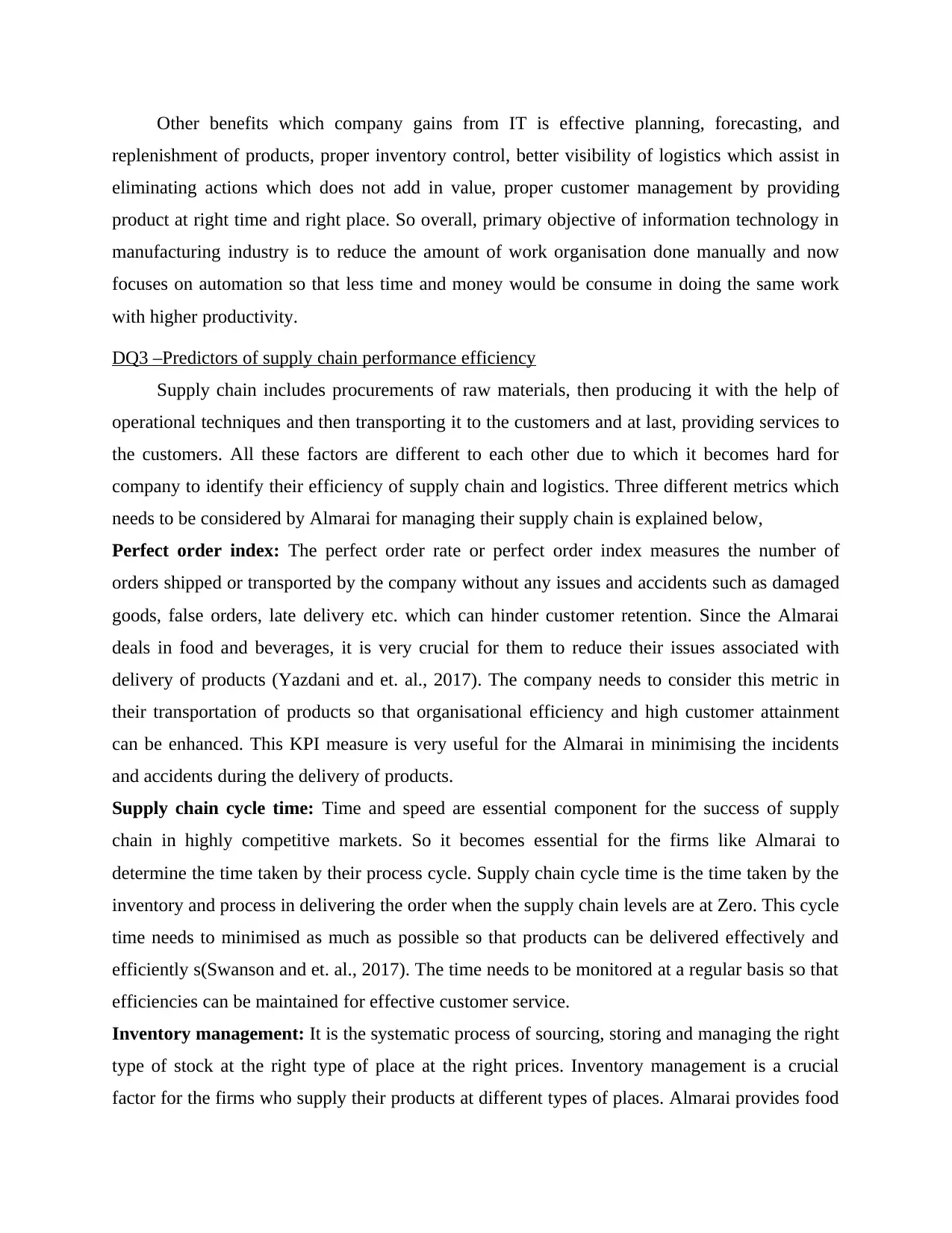
Other benefits which company gains from IT is effective planning, forecasting, and
replenishment of products, proper inventory control, better visibility of logistics which assist in
eliminating actions which does not add in value, proper customer management by providing
product at right time and right place. So overall, primary objective of information technology in
manufacturing industry is to reduce the amount of work organisation done manually and now
focuses on automation so that less time and money would be consume in doing the same work
with higher productivity.
DQ3 –Predictors of supply chain performance efficiency
Supply chain includes procurements of raw materials, then producing it with the help of
operational techniques and then transporting it to the customers and at last, providing services to
the customers. All these factors are different to each other due to which it becomes hard for
company to identify their efficiency of supply chain and logistics. Three different metrics which
needs to be considered by Almarai for managing their supply chain is explained below,
Perfect order index: The perfect order rate or perfect order index measures the number of
orders shipped or transported by the company without any issues and accidents such as damaged
goods, false orders, late delivery etc. which can hinder customer retention. Since the Almarai
deals in food and beverages, it is very crucial for them to reduce their issues associated with
delivery of products (Yazdani and et. al., 2017). The company needs to consider this metric in
their transportation of products so that organisational efficiency and high customer attainment
can be enhanced. This KPI measure is very useful for the Almarai in minimising the incidents
and accidents during the delivery of products.
Supply chain cycle time: Time and speed are essential component for the success of supply
chain in highly competitive markets. So it becomes essential for the firms like Almarai to
determine the time taken by their process cycle. Supply chain cycle time is the time taken by the
inventory and process in delivering the order when the supply chain levels are at Zero. This cycle
time needs to minimised as much as possible so that products can be delivered effectively and
efficiently s(Swanson and et. al., 2017). The time needs to be monitored at a regular basis so that
efficiencies can be maintained for effective customer service.
Inventory management: It is the systematic process of sourcing, storing and managing the right
type of stock at the right type of place at the right prices. Inventory management is a crucial
factor for the firms who supply their products at different types of places. Almarai provides food
replenishment of products, proper inventory control, better visibility of logistics which assist in
eliminating actions which does not add in value, proper customer management by providing
product at right time and right place. So overall, primary objective of information technology in
manufacturing industry is to reduce the amount of work organisation done manually and now
focuses on automation so that less time and money would be consume in doing the same work
with higher productivity.
DQ3 –Predictors of supply chain performance efficiency
Supply chain includes procurements of raw materials, then producing it with the help of
operational techniques and then transporting it to the customers and at last, providing services to
the customers. All these factors are different to each other due to which it becomes hard for
company to identify their efficiency of supply chain and logistics. Three different metrics which
needs to be considered by Almarai for managing their supply chain is explained below,
Perfect order index: The perfect order rate or perfect order index measures the number of
orders shipped or transported by the company without any issues and accidents such as damaged
goods, false orders, late delivery etc. which can hinder customer retention. Since the Almarai
deals in food and beverages, it is very crucial for them to reduce their issues associated with
delivery of products (Yazdani and et. al., 2017). The company needs to consider this metric in
their transportation of products so that organisational efficiency and high customer attainment
can be enhanced. This KPI measure is very useful for the Almarai in minimising the incidents
and accidents during the delivery of products.
Supply chain cycle time: Time and speed are essential component for the success of supply
chain in highly competitive markets. So it becomes essential for the firms like Almarai to
determine the time taken by their process cycle. Supply chain cycle time is the time taken by the
inventory and process in delivering the order when the supply chain levels are at Zero. This cycle
time needs to minimised as much as possible so that products can be delivered effectively and
efficiently s(Swanson and et. al., 2017). The time needs to be monitored at a regular basis so that
efficiencies can be maintained for effective customer service.
Inventory management: It is the systematic process of sourcing, storing and managing the right
type of stock at the right type of place at the right prices. Inventory management is a crucial
factor for the firms who supply their products at different types of places. Almarai provides food
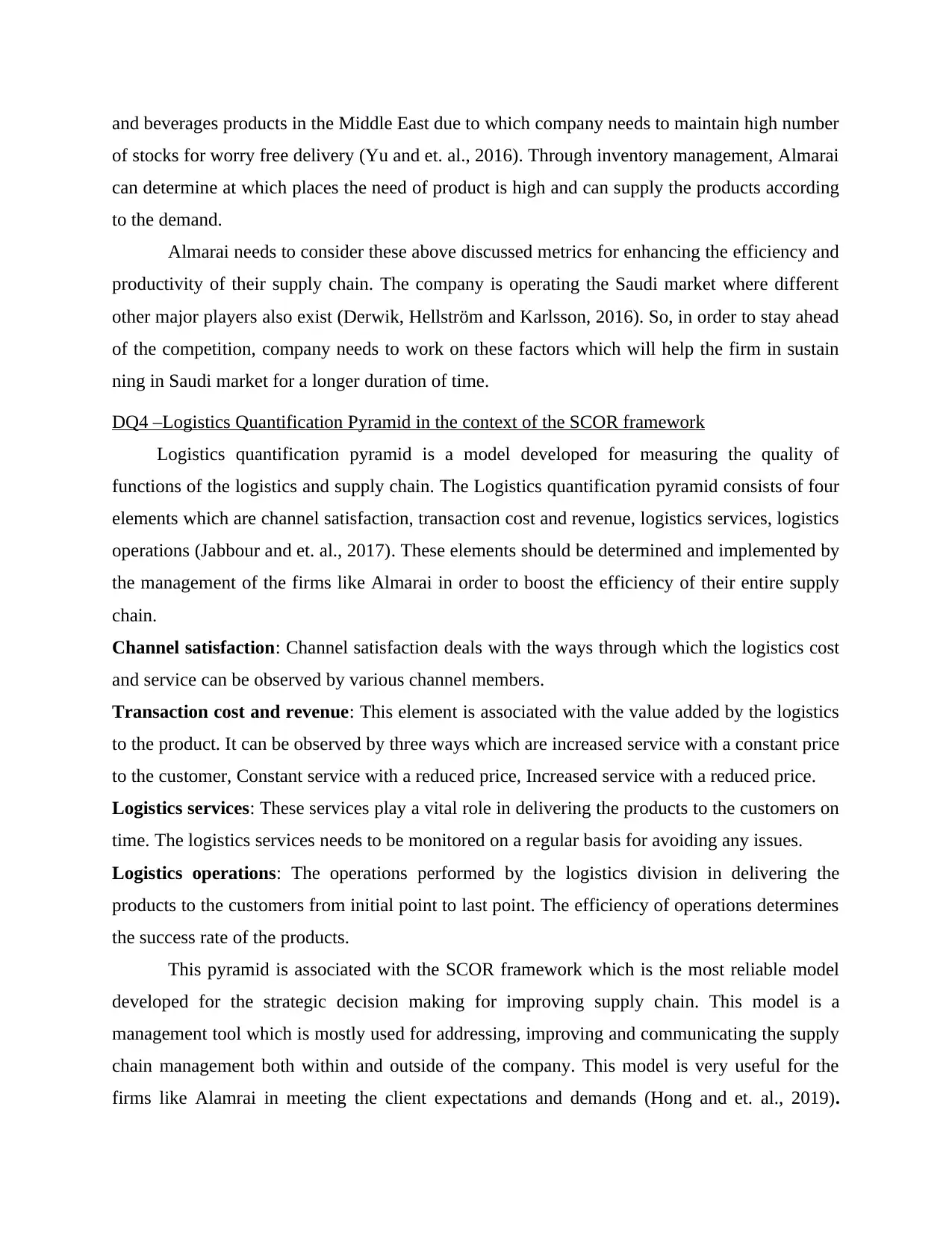
and beverages products in the Middle East due to which company needs to maintain high number
of stocks for worry free delivery (Yu and et. al., 2016). Through inventory management, Almarai
can determine at which places the need of product is high and can supply the products according
to the demand.
Almarai needs to consider these above discussed metrics for enhancing the efficiency and
productivity of their supply chain. The company is operating the Saudi market where different
other major players also exist (Derwik, Hellström and Karlsson, 2016). So, in order to stay ahead
of the competition, company needs to work on these factors which will help the firm in sustain
ning in Saudi market for a longer duration of time.
DQ4 –Logistics Quantification Pyramid in the context of the SCOR framework
Logistics quantification pyramid is a model developed for measuring the quality of
functions of the logistics and supply chain. The Logistics quantification pyramid consists of four
elements which are channel satisfaction, transaction cost and revenue, logistics services, logistics
operations (Jabbour and et. al., 2017). These elements should be determined and implemented by
the management of the firms like Almarai in order to boost the efficiency of their entire supply
chain.
Channel satisfaction: Channel satisfaction deals with the ways through which the logistics cost
and service can be observed by various channel members.
Transaction cost and revenue: This element is associated with the value added by the logistics
to the product. It can be observed by three ways which are increased service with a constant price
to the customer, Constant service with a reduced price, Increased service with a reduced price.
Logistics services: These services play a vital role in delivering the products to the customers on
time. The logistics services needs to be monitored on a regular basis for avoiding any issues.
Logistics operations: The operations performed by the logistics division in delivering the
products to the customers from initial point to last point. The efficiency of operations determines
the success rate of the products.
This pyramid is associated with the SCOR framework which is the most reliable model
developed for the strategic decision making for improving supply chain. This model is a
management tool which is mostly used for addressing, improving and communicating the supply
chain management both within and outside of the company. This model is very useful for the
firms like Alamrai in meeting the client expectations and demands (Hong and et. al., 2019).
of stocks for worry free delivery (Yu and et. al., 2016). Through inventory management, Almarai
can determine at which places the need of product is high and can supply the products according
to the demand.
Almarai needs to consider these above discussed metrics for enhancing the efficiency and
productivity of their supply chain. The company is operating the Saudi market where different
other major players also exist (Derwik, Hellström and Karlsson, 2016). So, in order to stay ahead
of the competition, company needs to work on these factors which will help the firm in sustain
ning in Saudi market for a longer duration of time.
DQ4 –Logistics Quantification Pyramid in the context of the SCOR framework
Logistics quantification pyramid is a model developed for measuring the quality of
functions of the logistics and supply chain. The Logistics quantification pyramid consists of four
elements which are channel satisfaction, transaction cost and revenue, logistics services, logistics
operations (Jabbour and et. al., 2017). These elements should be determined and implemented by
the management of the firms like Almarai in order to boost the efficiency of their entire supply
chain.
Channel satisfaction: Channel satisfaction deals with the ways through which the logistics cost
and service can be observed by various channel members.
Transaction cost and revenue: This element is associated with the value added by the logistics
to the product. It can be observed by three ways which are increased service with a constant price
to the customer, Constant service with a reduced price, Increased service with a reduced price.
Logistics services: These services play a vital role in delivering the products to the customers on
time. The logistics services needs to be monitored on a regular basis for avoiding any issues.
Logistics operations: The operations performed by the logistics division in delivering the
products to the customers from initial point to last point. The efficiency of operations determines
the success rate of the products.
This pyramid is associated with the SCOR framework which is the most reliable model
developed for the strategic decision making for improving supply chain. This model is a
management tool which is mostly used for addressing, improving and communicating the supply
chain management both within and outside of the company. This model is very useful for the
firms like Alamrai in meeting the client expectations and demands (Hong and et. al., 2019).
⊘ This is a preview!⊘
Do you want full access?
Subscribe today to unlock all pages.

Trusted by 1+ million students worldwide
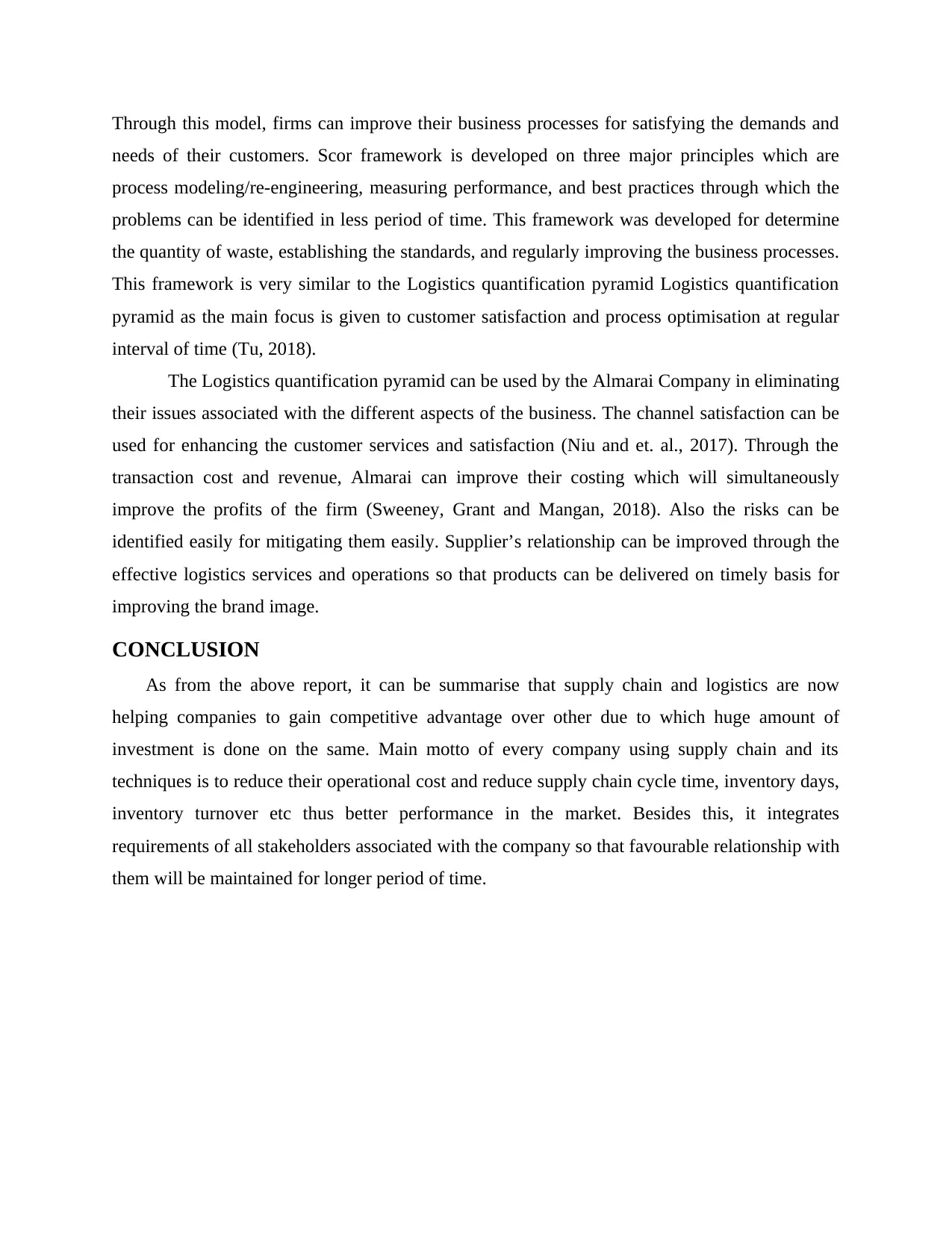
Through this model, firms can improve their business processes for satisfying the demands and
needs of their customers. Scor framework is developed on three major principles which are
process modeling/re-engineering, measuring performance, and best practices through which the
problems can be identified in less period of time. This framework was developed for determine
the quantity of waste, establishing the standards, and regularly improving the business processes.
This framework is very similar to the Logistics quantification pyramid Logistics quantification
pyramid as the main focus is given to customer satisfaction and process optimisation at regular
interval of time (Tu, 2018).
The Logistics quantification pyramid can be used by the Almarai Company in eliminating
their issues associated with the different aspects of the business. The channel satisfaction can be
used for enhancing the customer services and satisfaction (Niu and et. al., 2017). Through the
transaction cost and revenue, Almarai can improve their costing which will simultaneously
improve the profits of the firm (Sweeney, Grant and Mangan, 2018). Also the risks can be
identified easily for mitigating them easily. Supplier’s relationship can be improved through the
effective logistics services and operations so that products can be delivered on timely basis for
improving the brand image.
CONCLUSION
As from the above report, it can be summarise that supply chain and logistics are now
helping companies to gain competitive advantage over other due to which huge amount of
investment is done on the same. Main motto of every company using supply chain and its
techniques is to reduce their operational cost and reduce supply chain cycle time, inventory days,
inventory turnover etc thus better performance in the market. Besides this, it integrates
requirements of all stakeholders associated with the company so that favourable relationship with
them will be maintained for longer period of time.
needs of their customers. Scor framework is developed on three major principles which are
process modeling/re-engineering, measuring performance, and best practices through which the
problems can be identified in less period of time. This framework was developed for determine
the quantity of waste, establishing the standards, and regularly improving the business processes.
This framework is very similar to the Logistics quantification pyramid Logistics quantification
pyramid as the main focus is given to customer satisfaction and process optimisation at regular
interval of time (Tu, 2018).
The Logistics quantification pyramid can be used by the Almarai Company in eliminating
their issues associated with the different aspects of the business. The channel satisfaction can be
used for enhancing the customer services and satisfaction (Niu and et. al., 2017). Through the
transaction cost and revenue, Almarai can improve their costing which will simultaneously
improve the profits of the firm (Sweeney, Grant and Mangan, 2018). Also the risks can be
identified easily for mitigating them easily. Supplier’s relationship can be improved through the
effective logistics services and operations so that products can be delivered on timely basis for
improving the brand image.
CONCLUSION
As from the above report, it can be summarise that supply chain and logistics are now
helping companies to gain competitive advantage over other due to which huge amount of
investment is done on the same. Main motto of every company using supply chain and its
techniques is to reduce their operational cost and reduce supply chain cycle time, inventory days,
inventory turnover etc thus better performance in the market. Besides this, it integrates
requirements of all stakeholders associated with the company so that favourable relationship with
them will be maintained for longer period of time.
Paraphrase This Document
Need a fresh take? Get an instant paraphrase of this document with our AI Paraphraser
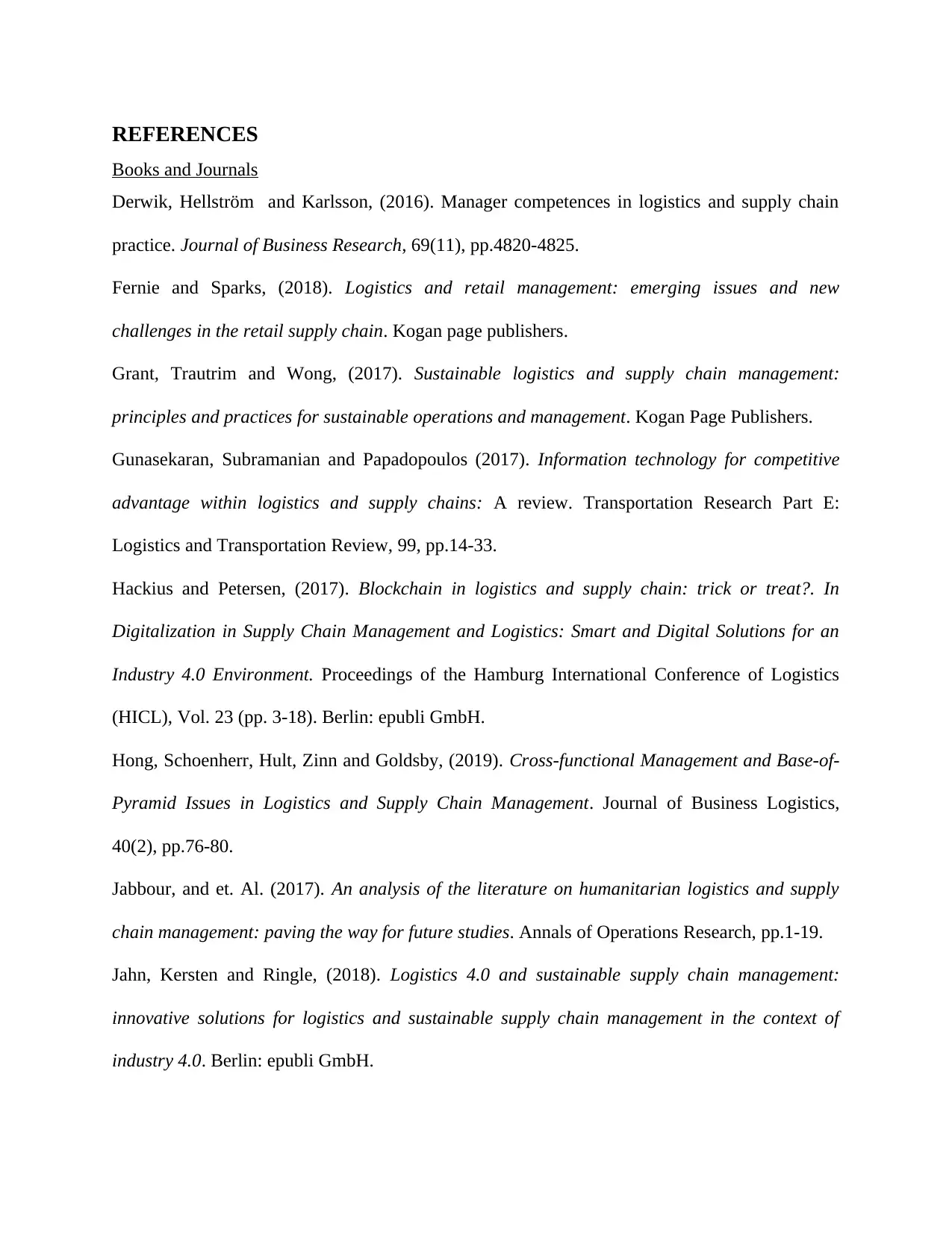
REFERENCES
Books and Journals
Derwik, Hellström and Karlsson, (2016). Manager competences in logistics and supply chain
practice. Journal of Business Research, 69(11), pp.4820-4825.
Fernie and Sparks, (2018). Logistics and retail management: emerging issues and new
challenges in the retail supply chain. Kogan page publishers.
Grant, Trautrim and Wong, (2017). Sustainable logistics and supply chain management:
principles and practices for sustainable operations and management. Kogan Page Publishers.
Gunasekaran, Subramanian and Papadopoulos (2017). Information technology for competitive
advantage within logistics and supply chains: A review. Transportation Research Part E:
Logistics and Transportation Review, 99, pp.14-33.
Hackius and Petersen, (2017). Blockchain in logistics and supply chain: trick or treat?. In
Digitalization in Supply Chain Management and Logistics: Smart and Digital Solutions for an
Industry 4.0 Environment. Proceedings of the Hamburg International Conference of Logistics
(HICL), Vol. 23 (pp. 3-18). Berlin: epubli GmbH.
Hong, Schoenherr, Hult, Zinn and Goldsby, (2019). Cross‐functional Management and Base‐of‐
Pyramid Issues in Logistics and Supply Chain Management. Journal of Business Logistics,
40(2), pp.76-80.
Jabbour, and et. Al. (2017). An analysis of the literature on humanitarian logistics and supply
chain management: paving the way for future studies. Annals of Operations Research, pp.1-19.
Jahn, Kersten and Ringle, (2018). Logistics 4.0 and sustainable supply chain management:
innovative solutions for logistics and sustainable supply chain management in the context of
industry 4.0. Berlin: epubli GmbH.
Books and Journals
Derwik, Hellström and Karlsson, (2016). Manager competences in logistics and supply chain
practice. Journal of Business Research, 69(11), pp.4820-4825.
Fernie and Sparks, (2018). Logistics and retail management: emerging issues and new
challenges in the retail supply chain. Kogan page publishers.
Grant, Trautrim and Wong, (2017). Sustainable logistics and supply chain management:
principles and practices for sustainable operations and management. Kogan Page Publishers.
Gunasekaran, Subramanian and Papadopoulos (2017). Information technology for competitive
advantage within logistics and supply chains: A review. Transportation Research Part E:
Logistics and Transportation Review, 99, pp.14-33.
Hackius and Petersen, (2017). Blockchain in logistics and supply chain: trick or treat?. In
Digitalization in Supply Chain Management and Logistics: Smart and Digital Solutions for an
Industry 4.0 Environment. Proceedings of the Hamburg International Conference of Logistics
(HICL), Vol. 23 (pp. 3-18). Berlin: epubli GmbH.
Hong, Schoenherr, Hult, Zinn and Goldsby, (2019). Cross‐functional Management and Base‐of‐
Pyramid Issues in Logistics and Supply Chain Management. Journal of Business Logistics,
40(2), pp.76-80.
Jabbour, and et. Al. (2017). An analysis of the literature on humanitarian logistics and supply
chain management: paving the way for future studies. Annals of Operations Research, pp.1-19.
Jahn, Kersten and Ringle, (2018). Logistics 4.0 and sustainable supply chain management:
innovative solutions for logistics and sustainable supply chain management in the context of
industry 4.0. Berlin: epubli GmbH.
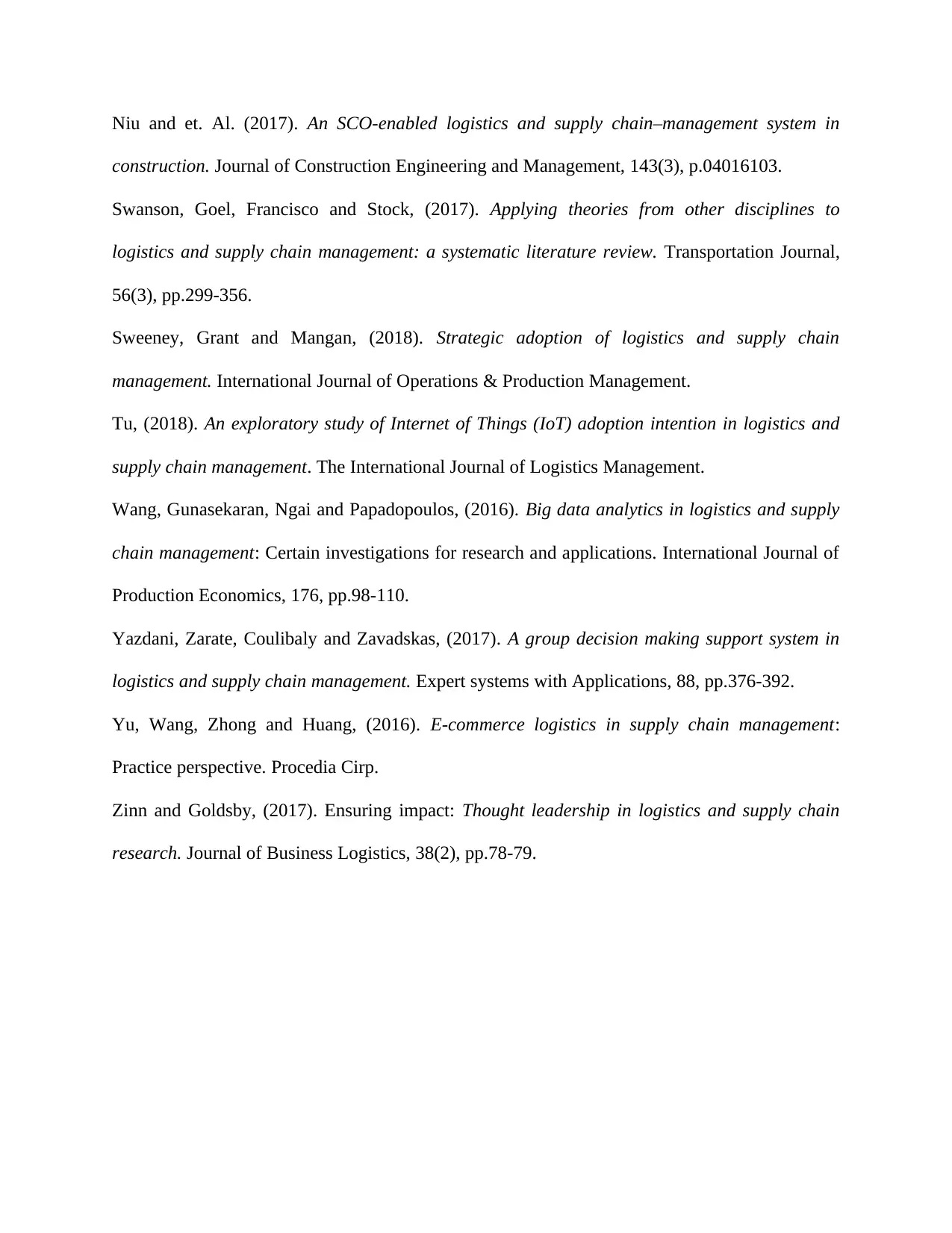
Niu and et. Al. (2017). An SCO-enabled logistics and supply chain–management system in
construction. Journal of Construction Engineering and Management, 143(3), p.04016103.
Swanson, Goel, Francisco and Stock, (2017). Applying theories from other disciplines to
logistics and supply chain management: a systematic literature review. Transportation Journal,
56(3), pp.299-356.
Sweeney, Grant and Mangan, (2018). Strategic adoption of logistics and supply chain
management. International Journal of Operations & Production Management.
Tu, (2018). An exploratory study of Internet of Things (IoT) adoption intention in logistics and
supply chain management. The International Journal of Logistics Management.
Wang, Gunasekaran, Ngai and Papadopoulos, (2016). Big data analytics in logistics and supply
chain management: Certain investigations for research and applications. International Journal of
Production Economics, 176, pp.98-110.
Yazdani, Zarate, Coulibaly and Zavadskas, (2017). A group decision making support system in
logistics and supply chain management. Expert systems with Applications, 88, pp.376-392.
Yu, Wang, Zhong and Huang, (2016). E-commerce logistics in supply chain management:
Practice perspective. Procedia Cirp.
Zinn and Goldsby, (2017). Ensuring impact: Thought leadership in logistics and supply chain
research. Journal of Business Logistics, 38(2), pp.78-79.
construction. Journal of Construction Engineering and Management, 143(3), p.04016103.
Swanson, Goel, Francisco and Stock, (2017). Applying theories from other disciplines to
logistics and supply chain management: a systematic literature review. Transportation Journal,
56(3), pp.299-356.
Sweeney, Grant and Mangan, (2018). Strategic adoption of logistics and supply chain
management. International Journal of Operations & Production Management.
Tu, (2018). An exploratory study of Internet of Things (IoT) adoption intention in logistics and
supply chain management. The International Journal of Logistics Management.
Wang, Gunasekaran, Ngai and Papadopoulos, (2016). Big data analytics in logistics and supply
chain management: Certain investigations for research and applications. International Journal of
Production Economics, 176, pp.98-110.
Yazdani, Zarate, Coulibaly and Zavadskas, (2017). A group decision making support system in
logistics and supply chain management. Expert systems with Applications, 88, pp.376-392.
Yu, Wang, Zhong and Huang, (2016). E-commerce logistics in supply chain management:
Practice perspective. Procedia Cirp.
Zinn and Goldsby, (2017). Ensuring impact: Thought leadership in logistics and supply chain
research. Journal of Business Logistics, 38(2), pp.78-79.
⊘ This is a preview!⊘
Do you want full access?
Subscribe today to unlock all pages.

Trusted by 1+ million students worldwide
1 out of 9
Related Documents
Your All-in-One AI-Powered Toolkit for Academic Success.
+13062052269
info@desklib.com
Available 24*7 on WhatsApp / Email
![[object Object]](/_next/static/media/star-bottom.7253800d.svg)
Unlock your academic potential
Copyright © 2020–2025 A2Z Services. All Rights Reserved. Developed and managed by ZUCOL.





